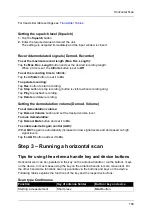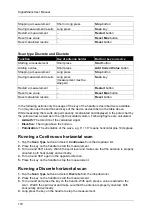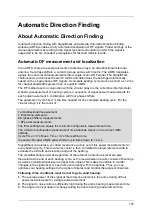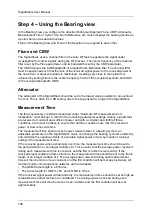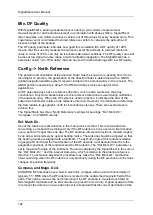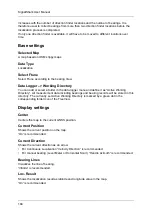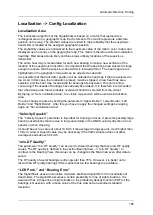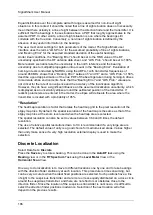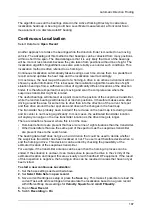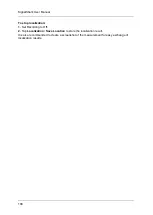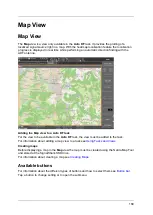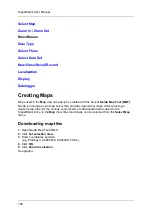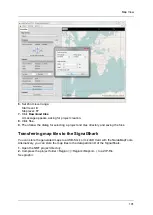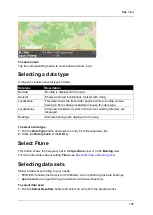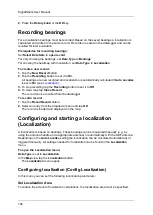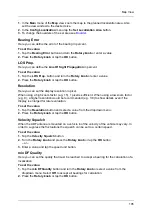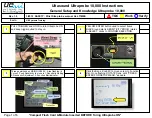
SignalShark User Manual
182
Min. DF Quality
With SignalShark a bearing measurement or bearing cycle consist of several level
measurements for each antenna element in combination with phase shifters. SignalShark
than calculates a so called covariance vectors out of this values for every bearing cycle. This
covariance vector is correlated to stored reference vectors to calculate the azimuth and
elevation angle of the bearing.
The DF quality parameter indicates how good this correlation fits. A DF quality of 100%
means, that the currently measured covariance vector fits perfectly to a stored reference
value. A value of 100 % can only be reached under ideal conditions. The DF quality value will
be less at low signal to noise ratios, or with multipath propagation. The SignalShark has a
parameter called “min. DF Quality” that can be used to discard bearings with low DF quality.
Config –> North Reference
The position and orientation of the direction finder must be known for a bearing from it to be
meaningful. In practice, the geolocation of the direction finder is determined with a GNSS
(global navigation satellite system) receiver located in the antenna array or the receiver. The
GNSS position uncertainty is about 15 m RMS and thus precise enough for most
applications.
All DF antenna arrays have a reference direction, which is also marked on the array
construction. Only AoA values relative to this reference direction are used during calibration
of the antenna array. When the DF system is used in practice, it indicates the AoA of the
suspicious transmitter relative to its reference direction. However, it is desirable to determine
the AoA relative to geographic north for localization purposes. There are several ways to
achieve this.
The SignalShark has three “North Reference” settings for bearings: “Ref. Mark Dir.”,
“Compass”, and “GNSS velocity”.
Ref. Mark Dir.
Use of the reference mark direction is the most precise method. This is somewhat time-
consuming, so it should be employed only if the DF antenna is to be used at a fixed location
over a period of longer than one day. The DF antenna reference direction is marked roughly
by an arrow and precisely by optical bearing marks. The antenna should be adjusted so that
the bearing marks are aligned with a landmark. The azimuth angle of this landmark relative
to geographic north and the fixed location of the DF antenna must be determined from the
geographic positions of the landmark and the DF antenna. The “Ref Mark Dir.” parameter is
set to the azimuth angle of the landmark. The AoA indicated by the SignalShark is the sum of
the “Ref. Mark. Dir.” and the internal AoA value, which is relative to the antenna reference
direction. The extensive adjustment procedure may make the “Ref. Mark Dir.” method too
time-consuming when the DF antenna is only stationary during the DF process but otherwise
changes its position frequently.
Compass and Magn. Decl.
All NARDA DF antennas have a built-in electronic compass with an azimuth uncertainty of
typically 1.5° RMS when the DF antenna is located in the undisturbed magnetic field of the
earth. This can be used as the north reference if the DF antenna is mounted such that no
ferromagnetic materials and no DC currents are present in its vicinity. A good example of this
is to mount the antenna on a wooden tripod. It is important that the correct declination of the
Summary of Contents for Narda SignalShark
Page 1: ...User Manual Version 2019 07 ...
Page 2: ......
Page 14: ......
Page 15: ...15 Online Help Version 2019 07 ...
Page 16: ......
Page 31: ...Introduction 31 Figure Loop antenna frequency range 9 kHz to 30 MHz ...
Page 32: ......
Page 38: ......
Page 44: ......
Page 60: ......
Page 66: ......
Page 74: ......
Page 88: ......
Page 104: ......
Page 118: ......
Page 132: ......
Page 158: ......
Page 198: ......
Page 204: ......
Page 214: ......
Page 226: ......


